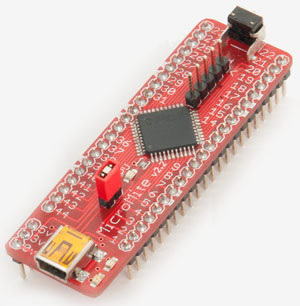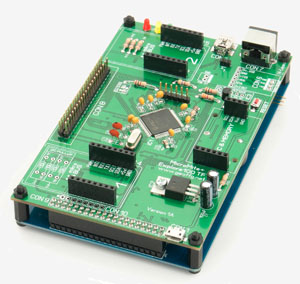The Micromite
![]()
![]()
![]() The Micromite is a Microchip PIC32 microcontroller programmed with the free MMBasic firmware. These chips cost from $4 to $10 and are available in packages from 28 pins to 100 pins. When programmed with the Micromite firmware they make a powerful and easy to program microcontroller that is ideal for most hobby projects.
The Micromite is a Microchip PIC32 microcontroller programmed with the free MMBasic firmware. These chips cost from $4 to $10 and are available in packages from 28 pins to 100 pins. When programmed with the Micromite firmware they make a powerful and easy to program microcontroller that is ideal for most hobby projects.
MMBasic is a Microsoft BASIC compatible implementation of the BASIC language with floating point, integer and string variables, arrays, long variable names, a built in program editor and many other features.
Using MMBasic you can use communications protocols, measure voltages, detect digital inputs and drive output pins. Special features include the ability to use touch sensitive LCD displays, temperature sensors, distance sensors and more.
You can use the Micromite as the intelligence inside any project that requires a medium speed microcontroller but without the hassle of programming in a complex language.
There are a two varients of the Micromite and many PCB boards and projects based on it. This page serves as a summary page for all of them, from here you can branch off to subsiduary web pages that describe each in detail.
At the bottom of this page you can download the manuals and firmware for all versions.
Micromite Microcontroller Chips
The Micromite is available in two versions: ![]()
- The standard Micromite comes in a 28 or 44-pin package, runs at a maximum speed of 48MHz and supports low cost 2.2" to 2.8" touch LCD panels. It has a focus on ease of use and low cost.
Jump to the standard Micromite page.
 The Micromite Plus is a more advanced version of the Micromite with double the memory and almost three times the speed (120MHz). It comes in 64 and 100-pin packages and supports a wider range of touch LCD panels up to 8". The Micromite Plus also supports SD cards for program and data storage, PS2 keyboard and advanced graphics controls including radio buttons, check boxes and on screen keyboards.
The Micromite Plus is a more advanced version of the Micromite with double the memory and almost three times the speed (120MHz). It comes in 64 and 100-pin packages and supports a wider range of touch LCD panels up to 8". The Micromite Plus also supports SD cards for program and data storage, PS2 keyboard and advanced graphics controls including radio buttons, check boxes and on screen keyboards.
Jump to the Micromite Plus page.
Micromite Explore 28, 64 and 100
These are small PCB modules that package the Micromite with the supporting components (power supply, serial to USB bridge for the console, etc) normally required in a project. Using these you can quickly test out an idea using a solderless breadboard and jumper wires without being concerned with mounting the Micromite itself onto a PCB.
 The Explore 28 is a small board designed by Graeme Rixon. It includes a 28-pin Micromite, a USB to serial converter, a USB socket and power supply and is designed to plug into a standard solderless breadboard. It is a very fast way of getting started, you just plug the USB into your desktop computer and you are off and running. The Explore 28 is available from rictech.nz.
The Explore 28 is a small board designed by Graeme Rixon. It includes a 28-pin Micromite, a USB to serial converter, a USB socket and power supply and is designed to plug into a standard solderless breadboard. It is a very fast way of getting started, you just plug the USB into your desktop computer and you are off and running. The Explore 28 is available from rictech.nz.
- 44-pin MicroMite Module is designed for the 44-pin version of the Micromite. Like the Explore 28 this module includes a USB to serial converter and a USB socket and power supply. The difference is that this uses the 44-pin Micromite so that you get many more I/O pins to play with. The PCB and other components are available from Silicon Chip magazine: https://www.siliconchip.com.au/Shop/8/2770
 The Explore 64 is a small board also designed by Graeme Rixon which includes a 64-pin Micromite Plus, a micro SD card socket, a USB socket and power supply and is designed to plug into a standard solderless breadboard.
The Explore 64 is a small board also designed by Graeme Rixon which includes a 64-pin Micromite Plus, a micro SD card socket, a USB socket and power supply and is designed to plug into a standard solderless breadboard.
Jump to the Explore 64 page.
 The Explore 100 is designed to fit on the back of a 5 inch touch sensitive LCD display panel. It includes a 100-pin Micromite Plus, USB socket, two sockets for Click Boards and a power supply. The combination of the Explore 100 and the LCD display panel make a rigid assembly that can be mounted in a box or a control panel.
The Explore 100 is designed to fit on the back of a 5 inch touch sensitive LCD display panel. It includes a 100-pin Micromite Plus, USB socket, two sockets for Click Boards and a power supply. The combination of the Explore 100 and the LCD display panel make a rigid assembly that can be mounted in a box or a control panel.
Jump to the Explore 100 page.
Micromite LCD Backpack
This is a printed circuit board designed to piggyback on a standard 2.4" or 2.8" touch sensitive LCD panel. It has less than a dozen components and can be built in half an hour.
 The combination of the Micromite with the colour LCD panel provides an amazing amount of power for less than US$25. The 320x240 pixel LCD can display colourful text and graphics and the touch sensitive input means that many manual knobs and switches can be replaced with on screen graphics. The eleven I/O pins can be used to measure temperature, distance, voltages, etc and under control of your BASIC program turn on lights, relays and other output devices.
The combination of the Micromite with the colour LCD panel provides an amazing amount of power for less than US$25. The 320x240 pixel LCD can display colourful text and graphics and the touch sensitive input means that many manual knobs and switches can be replaced with on screen graphics. The eleven I/O pins can be used to measure temperature, distance, voltages, etc and under control of your BASIC program turn on lights, relays and other output devices.
Jump to the Micromite LCD Backpack page.
Micromite Based Projects
This website hosts five projects based on the Micromite LCD Backpack. They are:
Interesting Web Sites
A video review of the original Micromite (almost everything applies to the Micromite MkII):
https://www.youtube.com/watch?v=V-Ym758Unmw
An up to date overview of the Micromite Mkll, the Micromite Plus and the Micromite Explore 100:
https://www.youtube.com/watch?v=C8ElrH1oq6k
The Back Shed forum is a great place to hang out and discuss the Micromite and microcontrollers:
http://www.thebackshed.com/forum/Microcontrollers
Getting Started with the Micromite
The Micromite is quite a sophisticated device, it is an almost complete computer with its own programming language and for newcomers there is a lot to learn.
The book Getting Started with the Micromite is a tutorial that assumes that the reader has had minimal exposure to microcontrollers and the BASIC programming language in particular. It starts with choosing the microcontroller, how to program the Micromite firmware into it and how to connect to the console. It then presents a beginners course in BASIC programming and moves onto some of the more specialised aspects of the Micromite including input/output, embedded features and communications protocols.
It is recommended reading for anyone who is new to the Micromite and can be downloaded from the download section at the bottom of this web page.
The first thing that you should read is the Micromite Frequently Asked Questions (FAQ) list as this covers hints related to usage and programming. The list is rather short at this time but as more questions arise it will be expanded.
Also, you should check the list of current bugs found in the Micromite version of MMBasic as it lists any faults found in the current version and provides workarounds if applicable.
The Back Shed has an active forum where many knowledgeable users are happy to help newcomers to the Micromite and MMBasic: http://www.thebackshed.com/forum/Microcontrollers
Online Manual
The user manual and a tutorial are available for download at the bottom of this page but another option for programmers is to use an online manual created by Jim Hiley of Tasmania. This covers all variants of MMBasic in one integrated online lookup tool. Go to: https://www.c-com.com.au/mmhelp/
Source Code to MMBasic
The complete source code for the Micromite version of MMBasic is available for personal use at the main MMBasic website at http://mmbasic.com.
Firmware Updates
A new versions of MMBasic (ver 5.05.05) for the Micromite, Micromite Plus and Windows/DOS is available and can be downloaded from the download area at bottom of this page. This is a minor update which fixes some obscure bugs (check the Change Log included in the zip file).
To load the new version you will need a PIC32 programmer. The best (and cheapest) programmer is the PICKit 3 by Microchip. Prices range from US$20 for a clone and it is easy to update the firmware - see this page for a tutorial. You can also build the Microbridge which is a very low cost PIC32 programmer - see this page for the details.
To save you from having to check this web page for firmware updates I can also send you an email. To enable this please enter your email address in the box below and click on Submit. Your address will be held confidential and will only be used when an update is available.
| Getting Started with the Micromite A tutorial introducing the reader to the Micromite and programming in the BASIC language. |
DOWNLOAD |
| Micromite User Manual | DOWNLOAD |
| Micromite Plus Manual | DOWNLOAD |
| Micromite Firmware V5.05.05 This includes both the standard Micromite (28 or 44 pins) and the advanced Micromite Plus (64 or 100 pins) firmware and all user manuals. |
DOWNLOAD |
Previous versions of the Micromite firmware can be found in the archive.
Other Downloads
| Micromite Lite Firmware V5.05.05 This is a cut down version of the standard firmware for the 28 or 44 pin Micromites with 25% more free program memory. The readme file lists the features that have been removed. |
DOWNLOAD |
| MMBasic Windows/DOS Version V5.05.05 This version is generally compatible with the Micromite version of MMBasic and runs on Windows (incl Windows 10). It includes file and serial I/O and is useful for programming in the Windows environment or for testing Micromite programs |
DOWNLOAD |
| Micromite eXtreme V5.04.08 for the PIC32MZ series (ported to the MZ by Peter Mather) | WEB SITE |
| Original Micromite Firmware 4.5E for the PIC32MX150F128 chip | DOWNLOAD |
| MMEdit, a full featured editor for MMBasic (it runs on your PC). By Jim Hiley | WEB SITE |
